 Is PMS ever normal? Is PMS ever normal? I had a new patient come into my office this week. A lovely, sweet young woman, she was concerned about her fertility and hormone health because since coming off the Pill, she felt "like a crazy person" 3 weeks of the month. She sat in my office and said "It's not enough. It's not fair that I only get one good week a month. What am I doing wrong?" She is right. So many women believe they have to put up with their periods. The cramps, the mood swings, the bloating (although in my books, you NEVER need an excuse to wear comfy pants!), the crappy libido... we're often told that we just need to suck it up. If we're expecting to have an average of 450 menstrual cycles throughout our lifetime (minus pregnancies) it is simply not enough to put up with feeling awful. The first step is information. Our sex-ed classes often focus so much on STI and pregnancy prevention (thankfully that's changing) and dry biology lessons that fail to teach young girls how to read their body's clues. Here's what IS normal:
Hormonal imbalances like low thyroid function, anxiety (YES, this can be caused by hormones!), heavy periods... or periods that have gone MIA or are ridiculously painful, infertility and mood swings from hell are NEVER normal. These things are common, but certainly not normal. A healthy woman that eats well, exercises the right amount for her body, gets enough rest (this is NOT just Netflix time), quality sleep and generally takes care of her body should not be experiencing these things. And she knows it. Masking it with medication is not the answer. Nor is powering through it for yet another awful cycle, or being told that she's crazy for asking questions about her ahead or being irrational or a hypochondriac. The answer is HONESTY. Has "everything" really and truly been tried? Consistently tried? For how long? If she is still drinking coffee like a Gilmore Girl or wine like a leading lady on Sex & The City, staying up too late or pretending that everything is OK because she's on the Pill "to regulate" per periods we're not being honest. Honesty with your health care provider should look like open communication, a commitment to lifestyle and dietary factors FIRST and if things are not improving, looking at the right tests. Looking outside the box where necessary. Consistent follow up and frank discussions about what is normal, what isn't. A completely personalized approach to fit YOUR needs. Coming from a 15+ year personal history of hormonal issues that resulted in so many missed periods, crazy hair loss, weight gain and terrible acne, I WISHED a physician back then would have taken this approach with me. Not that anyone was negligent... far from it. Most just didn't have the right tools. This same progressive approach that I take with women every. single. day. in my practice. The person-centred, I-actually-give-a-damn-about-you approach that helps you get back your cycle, get pregnant, age with grace, keep your sex drive and grow into the (boss) lady you are meant to be... it WORKS. If you are experiencing anything else, you may have a subtle.. or more obvious.. hormone imbalance. Your period should NOT be a nightmare. Let me help. Set up a complimentary Health Discovery Session with me. I love this video. Keep in mind that many of the symptoms we consider "normal" like bloating, acne and moodiness CAN be modified with an individualized Naturopathic plan to keep you feeling at the top of your game.
0 Comments
 Menopause and thyroid dysfunction: one is inevitable for women (if we are lucky to live that long) while the other is common. Both affect millions of women every year. The thyroid gland, which sits low in the neck, is considered one of the master hormone glands in the body and affects everything from our metabolism, cardiovascular function, the immune system, digestive health, mood and our body’s stress response. The thyroid especially affects our sex hormones. Menopause typically occurs for most women in their late 40s to early/mid 50s but can also be surgically or medication induced and involves dramatic changes to our sex hormones such as testosterone, estrogen, progesterone, DHEA, and cortisol. As these fluctuate many women start to experience symptoms that we commonly associate with menopause: mood swings, hot flashes, irregular or heavy menses, vaginal dryness and changes in hair and skin. Because these symptoms frequently occur, it is easy to confuse “common” with “normal” and chalk it all up the change. Not so fast. The thyroid gland acts like the thermostat of the body and is particularly vulnerable under times of stress. Major stressors like giving birth and being post-partum, being a student, mid-life, post-illness or surgery often coincide with major hormonal transitions like pregnancy, puberty, and menopause. When our body is under stress our thyroid gland kicks in to either rev us up or slow us down if we are in danger of burning out. Living a fast-paced life, many of us become susceptible to both sex hormone imbalances and thyroid disturbances. If our sex hormones are imbalanced, our thyroid function will be affected and vise versa. For example, depression, weight gain (particularly around the middle), scalp hair loss, body hair growth, menstrual irregularities, poor concentration, osteoporosis, fatigue, insomnia and low libido are common to both hypothyroidism (low thyroid function) and menopause. Since these patterns tend to be related to stress, it’s crucial to practice stress-reduction techniques and self-care (check out my Calm the F Down Self Care guide here), exercise and eat healthily. More importantly, however, we must determine the cause of these symptoms: poor thyroid function? Sex hormone imbalance? Both? Rather than spending time chasing your tail and taking unnecessary medications, it makes much more sense to determine the root cause of your symptoms. Getting a proper assessment is critical in establishing YOUR best course of action. In particular, I find the DUTCH Hormone test and a complete thyroid panel especially helpful. You may also want to look into these other tests for fatigue and hormonal imbalance. Often bioidentical hormone replacement therapy can be a game-changer for women throughout the peri-menopausal years and beyond to help restore quality sleep, balance moods and reduce heavy bleeding. Thyroid and hormone imbalances are common and can be improved when working with a Naturopathic Doctor as part of an individualized treatment plan to age gracefully with plenty of energy as you enter this exciting time of life. Sound like you? Have questions about your thyroid or hormones? Book a complimentary Health Discovery Session with me to chat more about your options. In health,
 7 Steps for Optimizing Your Vitamin D and Enjoying the Sun (safely). Keila Roesner ND. 7 Steps for Optimizing Your Vitamin D and Enjoying the Sun (safely). Keila Roesner ND. I was on away on a girls’ weekend recently. A gorgeous sunny day exploring Niagara wine country (this ND enjoys a glass of wine too!), laughing our butts off and trying not to fall off our bikes. It was a perfect opportunity to work on my “base tan” for the year. As a fair-skinned gal of Irish descent… I’m prone to grow freckles and get very very pink. Unlike my husband who gets a gorgeous tan every year, I have to be careful. But I certainly don’t avoid the sun. Ever. But wait, isn’t the sun the root of all evil? Skin cancer, melanoma and awful peeling skin? If the sun going to kill me… how come my ancestors survived?  The link here is Vitamin D. Vitamin D is an essential hormone and we are designed to get lots of it by being outside in the sun, moving around outdoors and enjoying the world around us. The challenge is that many of us spend our days inside working avoiding the sun between 10-2 pm, wearing sunscreen with a high SPF every day under our makeup and long light layers we can become very deficient. This is a big deal. Vitamin D is critical for our immune system. Many of us know about Vitamin D for bone health - Vitamin D helps regulate calcium and phosphorus absorption and excretion in the body. This is why many products are fortified with a synthetic version. Run of the mill health issues like coughs, colds, allergies, flus and other common issues are related to low Vitamin D levels that compromise our immune function. Vitamin D also keeps our immune system communicating so that we reduce our risk of more serious issues like Type 2 Diabetes, osteoporosis, heart disease, cancers and other autoimmune diseases like multiple sclerosis and rheumatoid arthritis. Low Vitamin D is also related to thyroid disease, mental health issues and hormone health. Adequate vitamin D is essential for digestive health as well, and when we are deficient we get leaky gut. When we lack Vitamin D our immune system loses touch with itself and we are more likely to get sick. Who is at risk?
Where can you get it?
Next Steps:
Vitamin D keeps your brain sharp, skin glowing, immune system humming along and is an essential part of your life. Practice safe sun, but don't fear it! Keep on the sunny side, 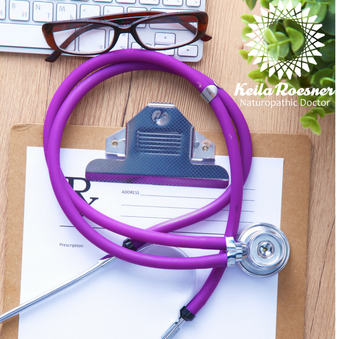
It is a persistent ache-in-your-bones feeling, like walking through mud every day and struggling to do the little things. It is the disorientation of not feeling like yourself for the past few weeks, months or years. It clouds your brain, steals your sense of humour and weighs heavily on your relationships. And then there’s the guilt and self-judgement about why you just can’t seem to get it together. One of the biggest struggles that people with persistent fatigue face is that outwardly they look normal. Coworkers, friends and families may offer “helpful” suggestions about being more organized or going to bed earlier (a great point, but not THE point) or completely fail to understand. Even physicians may struggle to help once the basic blood work comes back “normal”. Lifestyle factors can and do play a massive role, so it is critical to ensure that you are getting enough good quality sleep, eating well, exercising, managing stress and taking good care of yourself. Working with a therapist, registered massage therapist, personal trainer and your health team can be helpful to make sure you’re covering your bases. If you are already addressing these areas and still feel like something is missing, Naturopathic Medicine can be a great solution. The next step is digging deeper and doing a thorough investigation to determine the cause of the fatigue and how these factors might be affecting your overall health. Here are some of the most important lab tests that we run to assess the fatigue you’re experiencing. Ferritin and iron panel – ferritin, % saturation, serum iron and total iron binding
Vitamin B12
Thyroid Panel – a full panel includes TSH, free T4, free T3, reverse T3 and anti-TPO
DUTCH Hormone Test
Autoimmune and Inflammatory Markers – hs-CRP, ESR, ANA, rheumatoid factor, tissue transglutaminase IgG and/or IgA
Organic Acids Test
Other factors to consider: You know yourself best. If you feel that something is off, you are probably right. It is better to know where you stand and choose to work with a health care provider that can offer you the evaluations you need to get to the bottom of things. A thorough investigation is important, but it is even more important to have a plan in place to address what you find. Diet and lifestyle factors like how you eat, how you move, how you sleep and managing your stress will ALWAYS need to be a part of any treatment plan you undertake. It can be easy to get caught up in a complicated regimine of supplements and medications, but focusing on a strong foundation is what really determines your outcome. If you have “tried everything”, have you been consistent enough? Being fatigued IS exhausting and it is only natural to get excited about the next newest thing… but nothing will work if you don’t give it a fair shot. You need a team. The support of a partner or friend or online community can make a world of difference when you are suffering from an invisible illness. Work together with your health care providers to get the right assessments and guidance to help you recover. If you feel unsupported, unheard or like you are bothering your provider, find another professional to work with that will take your concerns seriously. Working with a Naturopathic Doctor to address the causes of chronic fatigue can be invaluable to your recovery by helping you systematically address each of the areas above and make a concrete plan based on YOU. If this sounds like you, I invite you to schedule a complimentary Health Discovery session with me to talk more about your specific concerns. Please share this article with someone you know that is suffering. In health, Click here for more information regarding the tests and services we offer.
References:
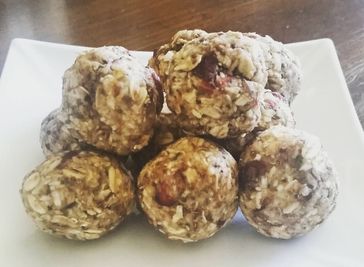 A delicious, healthy, simple vegan, dairy-free gluten-free make-ahead no-fuss snack. A delicious, healthy, simple vegan, dairy-free gluten-free make-ahead no-fuss snack. No-bake energy bites are the perfect healthy snack: easy to make, customize-able based on your pantry ingredients, and they store incredibly well in the freezer. Use this recipe as a guide but feel free to make substitutions based on your tastes. You can easily double – or quadruple this recipe, and kids can help. Perfect for last minute potlucks, people with food sensitivities and to throw together when you’re short on time and energy. Prep Time: 10 minutes Chill Time: 30 minutes Cook Time: nada Yield: 20-25 balls Ingredients:
Directions:
Other ideas:
 Creating a strong self-focused morning routine is one of the most important things you can do to set the tone for your day. Do you find yourself checking your email first thing in the morning and mentally answering questions… hours before you get into work? Rushing around in the morning, cramming breakfast in your mouth as you drive to work, already feeling that sense of impending anxiety and wishing you had more time for yourself? Feeling like your day is happening to you? Me too. Or rather, I used to feel that way. As an entrepreneur, I am more than a little obsessed with time management and productivity. As a Naturopathic Doctor, I am all about helping people create systems in their life to reach their health goals so that they can be more successful at work, and be the parent/partner/person they dream of being. I fell into the habit of auto-piloting my mornings, basing my schedule around when my husband needed to leave for work (ridiculously early), other roommates’ schedules and how much time I could spend falling into the black hole that is my Facebook Newsfeed. I would fly into the office just a few minutes before my first client, feeling a frazzled and unsettled. It is a recipe for anxiety and unproductivity. You feel like you are constantly chasing your tail and wind up frustrated by your lack of accomplishment at the end of the day. You stay up late catching up… or watching Netflix and always feeling perma-tired. Recently, I’ve been experimenting with a new “system”. Most successful entrepreneurs, top earners (C-office types) and the calmest people I know get up early. As a night-hawk born of two musicians, this concept is totally alien to me. I’ve gotten into the habit over the past few years, however, due to my husband’s schedule and the desire to spend time together before the day gets crazy. It’s actually very peaceful to be up and moving before the rest of the world. Once I’m up, I never regret it. Enter the Morning Triathlon: a super efficient start to the day to help you feel healthier, happier and more successful. Here’s why it works: By starting your day focusing on YOUR needs, you set a strong foundation for the rest of the day. Your email inbox and work day are full of other people’s demands for your time and energy… but by starting and ideally ending the day focusing on yourself, you will feel calmer and more productive. I call this concept “book-ending”. Ie. You book-end your day getting in the right frame of mind for your day in the morning, and then winding down in the evening. Here’s how you do it: Figure out how much time you have, and divide into three blocks: Mental, Movement, Mindful/Meditate. This is your Morning Triathlon. Ideally you have about 15 minutes or longer. Skip the time you spend reading the news on your phone.
My morning routine starts like this:
Some days I use a 15 minute block of time, other days I have longer. I never regret getting up early or taking care of myself. Self-care is vital to your health. Get my NEW Guide Calm the F*** Down: 5 Proven Strategies to Take Care of Yourself In my next blog post, I’ll share with you my favorite ways to build the perfect bedtime routine to help ward off insomnia. What are YOUR favorite ways to start your morning? Comment below! In health, Dr. Keila Roesner BHSc ND
 Conquer the common cold like a boss. Conquer the common cold like a boss. The common cold: It happens to the best of us...but what if you could prevent it? Whether you pick it up from your kids at daycare or there’s something going around the office it might seem inevitable to catch a cold once a year… or more. Maybe not. The common cold is used to describe a cluster of typical symptoms - sneezing, sinus congestion, runny nose, sore throat, and headaches – but can actually be caused by more than 35 different viral strains. And each of these strains can adapt and mutate. So yes, there is ALWAYS something going around. The question is: are you vulnerable? While we commonly think of October-March as “cold and flu season”, I tend to disagree. Yes, viruses are more common during this time. On the other hand, we are also busier and more stressed. Between Halloween, Thanksgiving, Christmas/Hannukah/Kwanza, New Years, Valentines Day and Easter sugar consumption is at an all time high. Most Canadians are deficient in Vitamin D – a potent immune support – unless we are also snow birds. We spend a lot more time indoors, breathing recycled air. So while colds are more common, we also have the odds stacked against us and our bodies aren’t always able to ward off viruses and bugs. The trick is building up your body’s resistance – since coming across the cold is inevitable – so that you are better able to withstand or bounce back quicker. 1. Eat more colorful vegetables. Different colors of vegetables offer different vitamins, antioxidants and healing properties so it’s a great idea to change up what you are eating. Almost all of us could stand to eat more too. Aim for 7 + servings per day. One serving is 2 handfuls of greens or 1 cup of other veggies. 2. Reduce exposure. Wash your hands with regular soap and water. Unless you are required to use hand sanitizer skip antibacterial hand soaps and sanitizers as many contain an ingredient called triclosan that is a known hormone disrupter. While we can’t always avoid exposure, keep your distance from people that are sick. Bring your own pen to the bank, keep tissues handy and wipe down common area surfaces with soap and water. 3. Go to bed. Getting enough sleep throughout the year is crucial. If you do get sick, stay home and rest to avoid infecting others. Unless you absolutely have to be somewhere, skip over-the-counter decongestants that contain acetaminophen… they are incredibly dehydrating. Your best bet is NOT pushing through the cold, but allowing your body the down time that it needs. While you’re at it, trying Magic Socks. 4. Drink lots of fluids. Ginger tea is one of my favorites, and plain water hot or cold is essential. Sneezing and coughing are incredibly dehydrating! Keep a humidifier in your bedroom also. 5. Make an individualized plan. Every year I run an Immune Booster program with my clients to keep them in tip top shape throughout the season. I find that a combination of herbals, homeopathics and vitamins customized to their needs, along with the above treatments, has been incredibly effective for reducing the risk of colds & flu and in the event that they do get sick, it is much less severe and passes quickly. What are your favorite go-to treatments to get over a cold? Comment below! If you found this article interesting please share. Looking to prevent the cold like a boss? Book an Immune Support visit with me to get started. References:
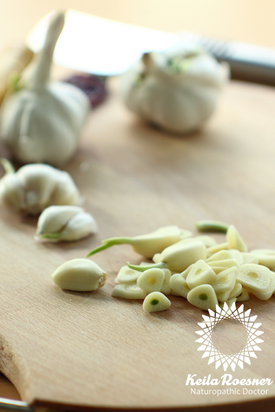 What can help ward off a cold, lower blood pressure, reduce cholesterol, improve blood glucose and help you lose weight… and is also deliciously addictive? Garlic and Olive Oil. The basis of a Mediterranean diet. When combined, these two pantry staples make a luxurious, flavorful condiment that is pretty wicked. As long as I can remember, my father grew the BEST garlic. Every year my mother would peel baskets full of fresh heads of garlic and freeze them for easy use while cooking for the rest of the year. She would often fill a mason jar with the fresh peeled cloves and olive oil so that I wouldn’t have to buy sub-par, bland garlic. When I was at Naturopathic College, I fell in love with shawarma. Roasted meat, pickled veggies… and the heavenly sauces. Nothing better at the end of a long day. It always seemed so complicated to make so I never really tried until a few years ago. My first trial? The addictive white garlicky sauce call toum… or as I call it “Crack Sauce”. It is seriously my favorite sauce to put on almost anything. This is by far the easiest and most authentic recipe I’ve tried and it’s packed with heart-healthy olive oil and garlic. You need:
Here’s what you do:
This sauce works beautifully with roasted meat and veggies or fish. Store in a sealed contained in the fridge for up to two weeks. Eat liberally during the cold months to help keep your immune system strong. Want to really reduce your risk of getting sick? Sign up for my natural Cold & Flu Prevention program. Have YOU ever tried Lebanese Garlic sauce? Comment below! In health, Dr. Keila Roesner BHSc ND
References
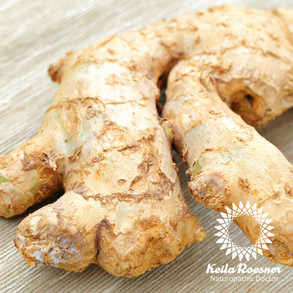 When the air starts to get a little chilly and you have a tickly in your throat… and your first thought is “Oh crap..!” what do you do? When there’s “something going around” and everyone around you has a cold, you might be exposed to any of the following viruses: Human Rhinovirus (over 100 strains!), Coronovirus (only about 5 infect humans), Human Parainfluenza Viruses, Adenoviruses and Respiratory Synctial Viruses. While there are plenty of folk remedies out there to ward off the common cold… some more effective than others. As a Naturopathic Doctor, I love working with herbs to help support the immune system, reduce congestion and speed recovery time. My favorite herbs to help fight off the common (but inconvenient!) cold include ginger, Echinacea, garlic, and andrographis. Ginger has long been used in Asia as a “warming” spice to improve circulation. Clinical studies have proven ginger to have some antiviral properties, can be effective against arthritis pain and inflammation and can be helpful for low appetite and nausea. Ginger can also help decrease menstrual cramps! And it’s always nice to sip on something warm! You need:
Here’s what you do:
Want to really reduce your risk of getting sick? Sign up for my natural Cold & Flu Support Program. In health, Dr. Keila Roesner BHSc ND
References
 Let’s face it: having a cold sucks. You know you’re going to be out of the game – or at least not at your best – for a few days. Having cold and kids – or kids with colds – is even worse. Contrary to popular belief, over-the-counter products marketed to help you push through the day are NOT the best way to get over a cold. While they can be helpful if you absolutely cannot miss a day, they do nothing to support your immune system. If you’ve been burning the candle at both ends, it’s not unusual for your body to take a little hit and become vulnerable to whatever virus is going around. The best cold & flu prevention is keeping your body in good shape so that your defenses don’t go down. In the event that you do find yourself under the weather, here’s one of my favorite ways to reduce congestion and support the immune system. I have consistently found that this helps reduce recovery time and helps me feel a lot more human. What is it? Magic Socks. Because they work so beautifully in kids, are safe, easy and inexpensive. I do this at the first sign of a cold, and recommend it to my patients as well. You need:
Here’s what you do:
Your socks should be completely dry by the morning with warm feet. Repeat for 2-3 nights to decrease sinus congestion and help you sleep. Now of course, you want to make sure that your feet are warm before starting the treatment, to avoid getting a chill. You will also want to do this as a part of your Naturopathic cold treatment program and work with your health care provider to make sure that you are recovering well and not dealing with a more serious health concern. As always, use your best judgement. Want to really reduce your risk of getting sick? Sign up for my natural Cold & Flu Prevention program. In health, Dr. Keila Roesner BHSc ND Reference: “Lectures in Naturopathic Hydrotherapy” by Wade Boyle, N.D & Andre Saine, N.D. Eclectic Medical Publications, Sandy Oregon 1988.
|
Top 75 Naturopath Blogs & Websites For Naturopathic DoctorsAuthorDr. Keila Roesner is a Naturopathic Doctor. When not treating patients she is also an enthusiastic barefoot-strolling, music-loving, yoga-doing kitchen wiz - who also happens to be a wrestling fan. Categories
All
|
Let us take you from hormonal to whole.
|
Dr. Keila Roesner, BHSc ND
Naturopathic Doctor, Hormone Warrior and Your Wellness Cheerleader 247 Church Street, Stratford ON N5A 2R7 (519) 273-0900 [email protected] |
|











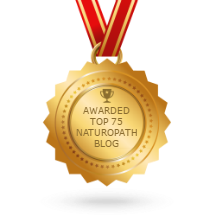
 RSS Feed
RSS Feed